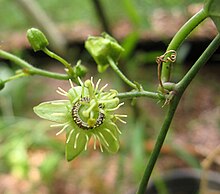Passiflora suberosa
| Passiflora suberosa | |
|---|---|

| |
| Scientific classification | |
| Kingdom: | Plantae |
| Clade: | Tracheophytes |
| Clade: | Angiosperms |
| Clade: | Eudicots |
| Clade: | Rosids |
| Order: | Malpighiales |
| Family: | Passifloraceae |
| Genus: | Passiflora |
| Species: | P. suberosa
|
| Binomial name | |
| Passiflora suberosa | |
| Synonyms[2] | |
|
Passiflora pallida L. | |
Passiflora suberosa is a species of
Description
Leaves and stems



It is a creeping or climbing perennial liana up to 6 meters long. It has suberous stems in its lower part, glabrous to puberulent.
The leaves are simple, alternate, entire to three-lobed, with both sides glabrous, shiny green. They are 4 to 12 centimeters long when elliptical and up to 5 cm long and 7 cm wide when deeply lobed, sharp lobes, base rounded to truncated, glabrous to puberulent;
The plant is known for the fact that the leaves on one and the same plant vary greatly in shape and size.[5] Another well-known phenomenon is that the lower part of the trunk becomes corky with aging.
Flowers and fruit
The melliferous flowers are solitary or in pairs, and grow in the
The inedible fruit is not hardy and transitions from green to indigo, purple and, lastly, black as it ripens. The glabrous fruits contain a multitude of tiny seeds in a dark blue pulp, which are dispersed by birds.[6]
Range
Its range stretches from
It is extremely prolific (up to 1000 seeds per square meter), smothering any vegetation it grows on, including trees. In New Caledonia, it is prohibited to introduce the species into the wild.[8]
Reproduction
Many clones of the plant are
This species is a host plant for the
References
- ^ "NatureServe Explorer 2.0". explorer.natureserve.org. Retrieved 21 November 2022.
- ^ a b c "Passiflora suberosa". Germplasm Resources Information Network. Agricultural Research Service, United States Department of Agriculture. Retrieved 2010-08-22.
- ^ corky passion vine Passiflora suberosa Brisbane City Council Weed Identification Tool
- ^ "Passiflora suberosa L." Useful Tropical Plants. Retrieved 3 July 2021.
- ^ Zona Ph.D., Scott (n.d.). "Shape Shifters". Fairchild Tropical Garden- Garden View. 57 (4): Photo and caption p. 17.
- ^ Hernández & N. García. 2006. Passion flowers (Passifloraceae family). Red Book Pl. Colombia 3: 3: 583–653.
- ^ a b "Corkystem Passionflower - Passiflora suberosa". North American Butterfly Association. Retrieved 2010-08-22.
- ^ Invasive species group, Invasive plants for the natural environments of New Caledonia , Nouméa, Agency for the prevention and compensation of agricultural or natural disasters (APICAN),january 2012, 222 p. , pp. 126-127
- .
- ^ Braby, M.F., Butterflies of Australia; Their Identification, Biology and Distribution. CSIRO Publishing 2000
External links
![]() Media related to Passiflora suberosa at Wikimedia Commons
Media related to Passiflora suberosa at Wikimedia Commons
![]() Data related to Passiflora suberosa at Wikispecies
Data related to Passiflora suberosa at Wikispecies

